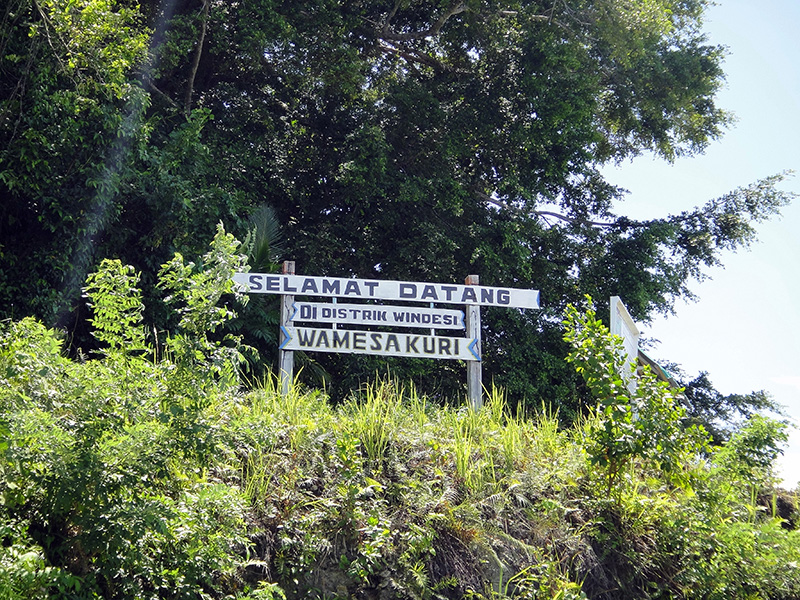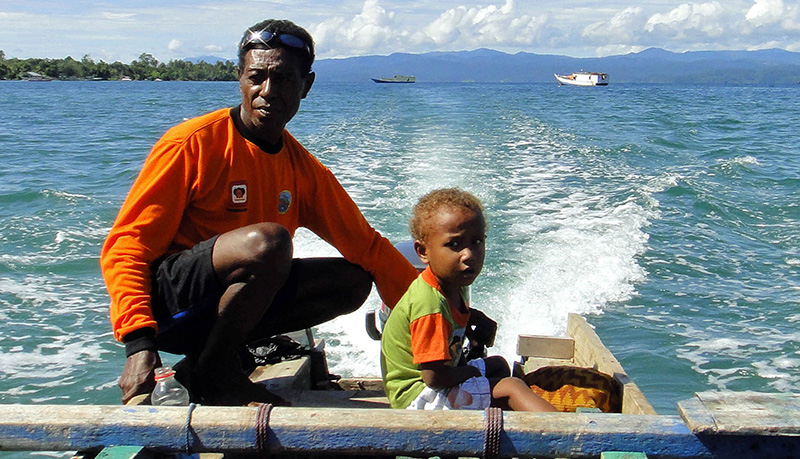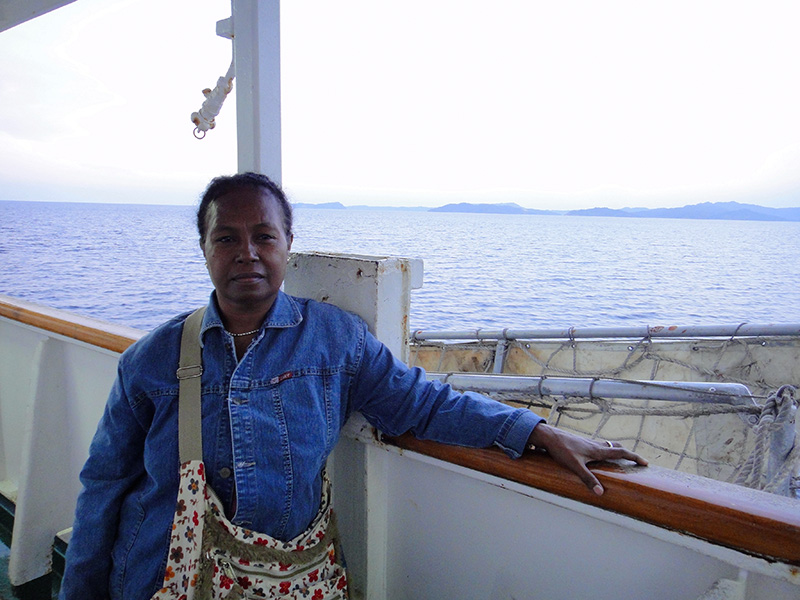About the Wamesa Dictionary by Abigail Crum & Emily Gasser
“Saya punya princip bahasa ini: Tuhan kasih, kita membagi. Tidak boleh sembunyi yang dapat. Tidak bagus. Harus membagi kepintaran buat orang.”
“My principle of language is this: God gave it, we share it. We can’t hide what we’ve received. That’s not good. We have to share our knowledge with people.”
- Ibu Marice KarubuyWamesa, sometimes called Wandamen, is an Austronesian language spoken in West Papua, Indonesia in the south-eastern Bird’s Head peninsula. Wamesa belongs to the South Halmahera-West New Guinea branch of Austronesian. There are roughly 6000 speakers of the language.
Native speakers call their language ‘Wamesa’ and use ‘Wandamen’ to refer to the dialect, spoken around Wandamen Bay (Teluk Wondama) (Gasser 2014). This dictionary focuses on the Windesi dialect of Wamesa, and is based on ongoing fieldwork begun in the summer of 2011.
 Map of Wamesa dialect regions. The Wandamen dialect is outlined in green, Windesi is in red, and the Bintuni dialect is in blue. From SIL (unpublished), adapted by E. Gasser and T. Karubuy.
Map of Wamesa dialect regions. The Wandamen dialect is outlined in green, Windesi is in red, and the Bintuni dialect is in blue. From SIL (unpublished), adapted by E. Gasser and T. Karubuy.
 Sign welcoming visitors to the Windesi District. Photo by Emily Gasser.
Sign welcoming visitors to the Windesi District. Photo by Emily Gasser.
 Pak Aukila Karubuy, a fluent Windesi speaker, left, with small child. Photo by Emily Gasser.
Pak Aukila Karubuy, a fluent Windesi speaker, left, with small child. Photo by Emily Gasser.
 Consultant Ibu Marice Karubuy, on a ship to Wasior. Ibu Ice passed away in November 2016. Photo by Emily Gasser.
Consultant Ibu Marice Karubuy, on a ship to Wasior. Ibu Ice passed away in November 2016. Photo by Emily Gasser.
.jpg) Emily Gasser with staff from the Center for Endangered Languages Documentation in Manokwari (Yusuf Sawaki, Cika Tethool and Eny Ronie).
Emily Gasser with staff from the Center for Endangered Languages Documentation in Manokwari (Yusuf Sawaki, Cika Tethool and Eny Ronie).
About The Wamesa Language
Phoneme Inventory
Wamesa uses the following consonants in native vocabulary. Additionally, l [l] and j [dʒ] appear in loan words.
Wamesa has five contrasting vowels: a, i , e, o, u.
Wamesa also allows a range of vowel sequences, including the following dipthongs and tripthongs: au, ai, ei, oi, ui, ia, ie, io, ua, ui, uo, ioi, iau. A selection of these vowel sequences are noted with Wamesa examples in the following table. Vowel sequences never include adjacent non-high vowels, and unstressed i and u often lenite to y and w adjacent to other vowels (Gasser 2014).
| Wamesa orthography | IPA symbol | English and Indonesian examples | Wamesa examples |
|---|---|---|---|
| Consonants | |||
| P p | p | patpisang |
listen
parenipa palm |
| B b | b | ballbaru |
listen
bababig |
| T t | t | startelur |
listen
tomboroowl |
| D d | d | dogdatang |
listen
adiafire |
| K k | k | skirtkampung |
listen
makarabatsaltwater eel |
| G g | g | grabgempah |
listen
wanggarmouse |
| M m | m | mothermasih |
listen
mamaraclear, white |
| N n | n | namenanti |
listen
manaualready |
| Ng ng | ŋ | singertangan |
listen
nginggisicricket |
| V v | β | -- |
listen
vavorunew |
| S s | s | soupseni |
listen
masasabushattered |
| R r | r | -rumah |
listen
rauleaf |
| W w | w | windawan |
listen
wamarhornbill |
| Y y | j | yesayam |
listen
yauI, 1sg pronoun |
| L l | l | likelilin |
listen
kalawaifishing spear |
| J j | dʒ | jumpjelas |
listen
karanjangbasket |
| Wamesa Vowels | |||
| A a | a | popbapak |
listen
rago |
| E e | e | rainlembek |
listen
reeye |
| I i | i | peeppilih |
listen
ariweek |
| O o | o | bonekotor |
listen
mawogong |
| U u | u | rootmulut |
listen
ru nandauhair |
| Y y | j | yes |
listen
yabahouse |
| Some Wamesa Vowel Sequences | |||
| iau | iau | meow |
listen
niaucat |
| ioi | ioi | re-oil |
listen
nioiknife |
| iai | iai |
listen
ai kiaitoe |
|
| iou | iou | radio |
listen
ariouflower |
| iui | iui |
listen
viuihe/she/it writes |
|
Consonant clusters are allowed in Wamesa but they are limited to homorganic nasal + voiced stop (mb, nd, ngg) consonant + glide, and glide + consonant. Wamesa does not allow complex onsets, so clusters will not occur word initially or finally. Other underlying clusters are simplified in most cases by deleting the first member: /C1C2/ → [C2]. The -- somewhat odd -- exceptions to this rule are clusters ending in v, r, and k, which surface as mb, nd, and ngg, respectively.
Stress
Stress is not predictable in Wamesa, except that, when there is only one morpheme, primary stress must occur in a three syllable window at the end of a stem.
Syntax
Wamesa is an SVO language. Within the noun phrase, the word order is NADQ, or noun - adjective - determiner - quantifier. This is a particularly interesting word order, as it is violation of Greenberg’s Universal 20, and is quite rare cross-linguistically. Like many languages of the region, Wamesa has phrase-final negation.
Determiners
There are three definite determiners in Wamesa: =ne, =pa, and =wa . These mark literal and figurative distance between the speaker and what is being spoken about. These determiners can also denote the level of association the speaker has with the thing or person being spoken about, and as such are used to form the inalienable possessive construction. Determiners are marked for singular vs plural number if there is no numeral present.
=Ne is used for objects that are in very close proximity to the speaker, or that are very familiar to the speaker, or for 1sg inalienable possessors.
| ai=ne-i |
| tree=DET-SG |
| ‘the tree (that’s right here)’ |
=Pa is used for objects at a middle distance from the speaker. It also denotes third person singular inalienable possession.
| nando=pa-si |
| banana=DET-PL |
| ‘the bananas’ |
=Wa is used to mark something very far away from the speaker. This determiner is the least common among the definite determiners in Wamesa.
| wise=wa-i |
| mountain=DET-SG |
| ‘The mountain (way over there)’ |
Verbs
Wamesa verbs conjugate to agree with the subject of the sentence in person, number, and, in the third person plural, animacy. There is an inclusive/exclusive ("us including you" vs."us but not you") distinction in the first person, and both dual (two people), and plural (three or more) numbers. The trial (exactly three) is occasionally used, but the verb conjugates exactly as in the plural. The following chart includes affixes for subject agreement with verbs (Gasser 2014).
| ase | pera | ra | ||
|---|---|---|---|---|
| Prefix | ‘to swim’ | 'to cut’ | 'to go’ | |
| Singular | ||||
| 1sg | /i-/ | y-ase | i-pera | i-ra |
| 2sg | /bu-/ | bu-ase | p‹u›era | r‹u›a |
| 3sg | /di-/ | di-ase | p‹i›era | r‹i›a |
| Dual | ||||
| 1du incl | /tur-/ | tur-ase | tu-pera | tun-da |
| 1du excl | /amur-/ | amur-ase | amu-pera | amun-da |
| 2du | /mur-/ | mur-ase | mu-pera | mun-da |
| 3du | /sur-/ | sur-ase | su-pera | sun-da |
| Plural | ||||
| 1pl incl | /tat-/ | tat-ase | ta-pera | tan-da |
| 1pl excl | /amat/ | amat-ase | ama-pera | aman-da |
| 2pl | /met-/ | met-ase | me-pera | men-da |
| 3pl.human | /set-/ | set-ase | se-pera | sen-da |
| 3pl.nonhum | /si-/ | si-ase | si-pera | si-ra |
Other verbal affixes mark the essive, applicative, causative, and some aspects; enclitics give directionality and negation. Serial verbs are fairly common in Wamesa; all verbs in a serial construction must show subject agreement.
Thanks
We would like to thank all the Wamesa language consultants for their cooperation and contributions. All content is under copyright by the authors. Words and recordings remain the intellectual property of the speakers and community. This work was funded by NSF DEL grant #1153795, the Max Planck Institute for the Science of Human History, and Swarthmore College. Any questions or comments concerning this project can be sent to egasser1@swarthmore.edu.
References
Gasser, Emily. 2014. Windesi Wamesa Morphophonology. Ph.D. thesis, Yale University.